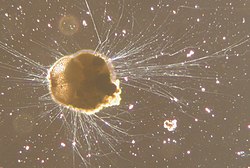Sarcomastigophora: Difference between revisions
m Reverted edits by 222.127.245.140 to last revision by 24.98.147.147 (HG) |
No edit summary |
||
| Line 21: | Line 21: | ||
==See also== |
==See also== |
||
sadasd joselito salamangka of philipins |
|||
*[[Protozoa]] |
|||
*[[Foraminifera]]fda |
|||
*[[Radiolaria]] |
|||
*[[Red Tide]] |
|||
==References== |
==References== |
||
Revision as of 06:20, 20 February 2009
| Protist | |
|---|---|
| Scientific classification | |
| Kingdom: | |
| Phylum: | Sarcomastigophora
|
The phylum Sarcomastigophora belongs to the Protist kingdom and it includes many unicellular or colonial, autotrophic, or heterotrophic organisms. The two main subphyla are Mastigophora and Sarcodina. A third is Opalinata.[1]
It is polyphyletic, and it is not a universally recognized classification. It places great significance upon method of locomotion in generating the taxonomy, but amoeboid organisms such as Dientamoeba fragilis are closely related to the flagellated trichomonads.
It can be described as kingdom Protista → phylum Sarcomastigophora → subphylum Mastigophora, or as phylum Protozoa → subphylum Sarcomastigophora → class Mastigophora.[2]
There is significant overlap between Sarcomastigophora and Excavata.
Subphylum Mastigophora
Mastigophora (also known as flagellates) is the sub-phylum of Sarcomastigophora, that contains protozoa that use flagella as their form of locomotion. There are about 8,500 living species of flagellates. Although there are several orders of marine flagellates, some of the better known and abundant are the dinoflagellates. Dinoflagellates often becomes so abundant and crowded in a lake or body of water, that it forms red tides. Most dinoflagellates are an important part of the phytoplankton and contribute significantly to the food sources of filter feeding zooplankton. Some species of dinoflagellates are bioluminescent and are partly responsible for the phosphorescent "sparkles" in bodies of water that result when moving objects or organisms disturb the water.
Subphylum Sarcodina

Sarcodina (also known as amoeboids) is the sub-phylum of Sarcomasitgophora, containing protozoa that use projections called pseudopods as their form of locomotion. There are about 13,500 living species of the subphylum Sarcodina. Two of the most ecologically important sarcodines are the Foraminifera and the Radiolaria. Some sarcodines may produce a glass casing around themselves to protect their delicate cytoplasm.
See also
sadasd joselito salamangka of philipins
References
- ^ Sarcomastigophora at the U.S. National Library of Medicine Medical Subject Headings (MeSH)
- ^ Dunster, Katherine; Dunster, Julian A. (1996). Dictionary of natural resource management. Vancouver: UBC Press. p. 337. ISBN 0-7748-0503-X.
{{cite book}}: CS1 maint: multiple names: authors list (link)
